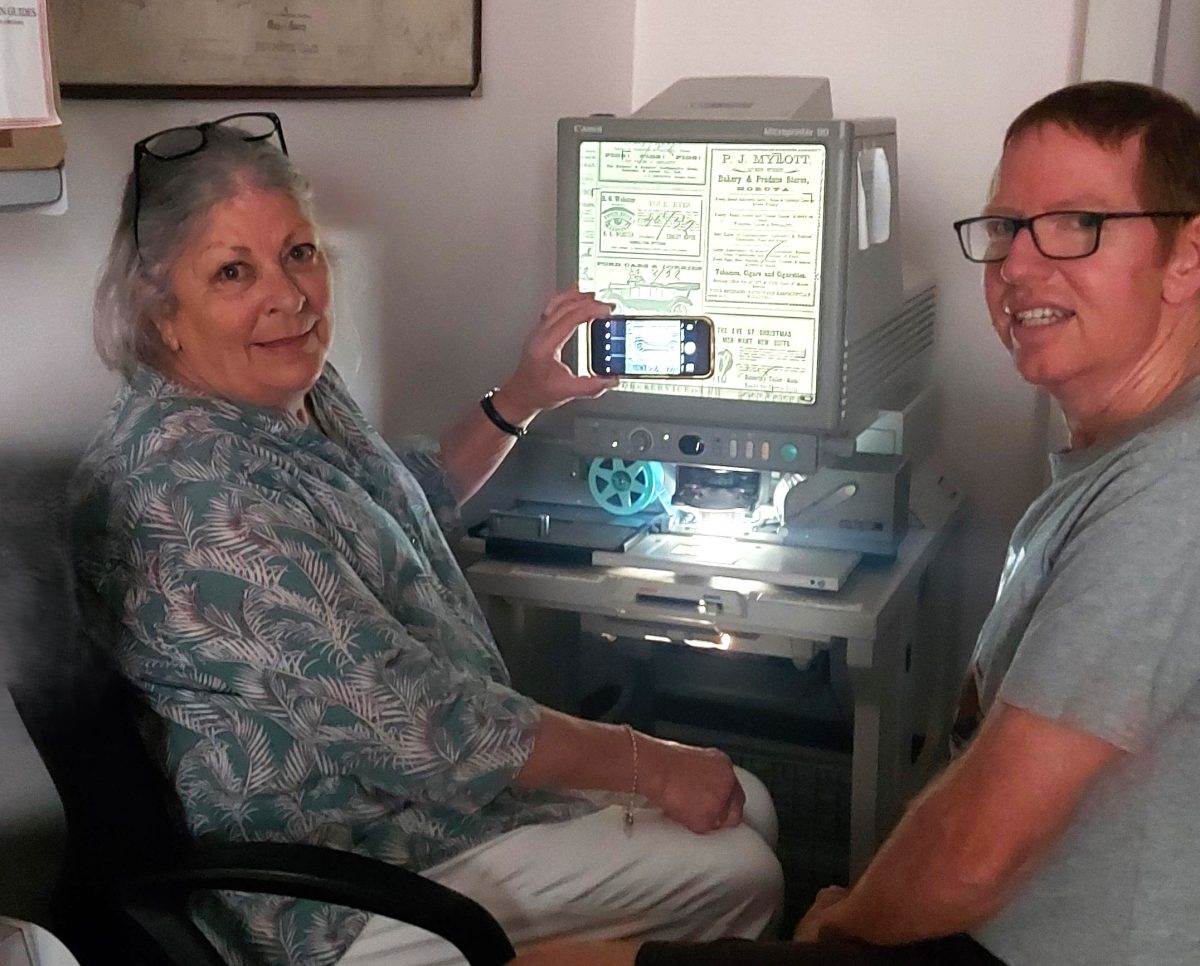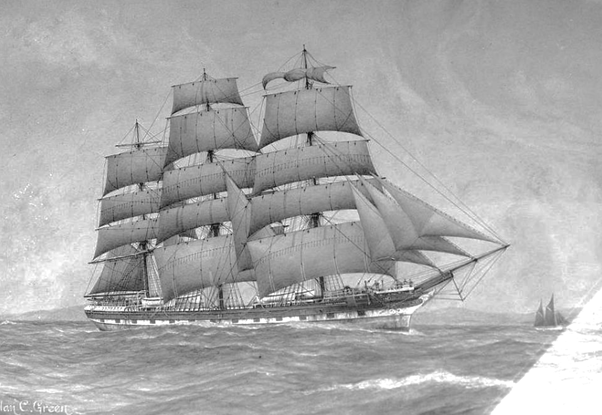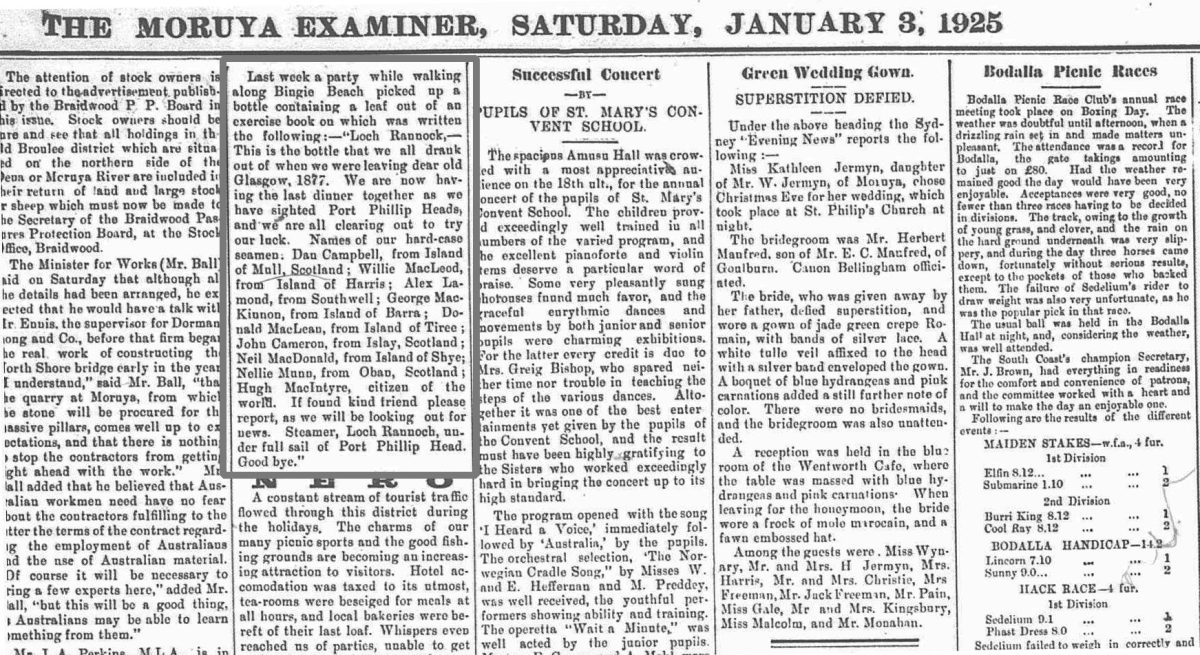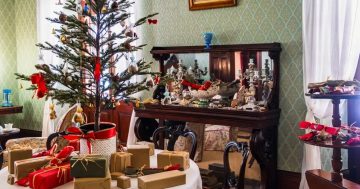
Yvonne Thomson and Julian Armstrong dig out historical treasures from 100 years ago. Photo: Moruya and District Historical Society.
Noisy neighbours, bad roads, and tales of troublesome tourists.
These are the types of stories that Moruya and District Historical Society members spend many hours trawling through for their long-running project News From 100 Years Ago.
But earlier this year, the researchers struck gold when they stumbled onto evidence of Australia’s oldest long-range message in a bottle and have spent much of this year verifying the story.
Researcher Julian Armstrong, who is a volunteer on the project, found the long-lost maritime evidence in what was little more than a titbit buried within an edition of The Moruya Examiner from January 1925.
The story contained no headline, which was a common occurrence in the print news of that era, and it simply stated that a party of walkers had come across a bottle washed up on Bingie Beach, south of Moruya.
With little explanation and no fanfare, the remainder of the news piece is a transcription of the message contained within the bottle.
Loch Rannock – this is the bottle that we all drank out of when we were leaving dear old Glasgow, 1877. We are now having the last dinner together as we have sighted Port Phillip Heads, and we are all clearing out to try our luck.
Names of our hard-case seamen: Dan Campbell, from Island of Mull, Scotland; Willie MacLeod, from Island of Harris; Alex Lamond, from Southwell; George MacKinnon, from Island of Barra; Donald MacLean, from Island of Tiree; John Cameron, from Islay, Scotland; Neil MacDonald, from Island of Skye; Nellie Munn, from Oban, Scotland; Hugh MacIntyre, citizen of the world.
If found kind friend, please report, as we will be looking out for news.
Steamer, Loch Rannoch, under full sail, Port Phillip Head.
Good bye.

A painting of Loch Rannock in full sail, by Allan C. Green, c 1868. Image: State Library of Victoria.
It might seem like a quaint story at first glance, but a little digging from Julian and the team revealed that long-range, sea-borne messages contained in bottles are quite rare – so rare, in fact, that this is only one of 60 globally that have been found more than 25 years after the bottle was launched.
“If we assume the report in the newspaper is correct, which I think is fair to do so, it would make it the oldest one found in Australia and the fourth oldest globally,” Moruya and District Historical Society president Susan Murphy said.
Sadly, the original bottle and its mysterious message are both lost to time, but Susan, an expert in local history, puts that into historical context to explain why they are likely no longer with us.
“If you think that you were wandering along the beach and found a bottle dating from the 1950s, you’d probably put it in the bin.”
Since the discovery of the Moruya Examiner story, the Moruya and District Historical Society has been able to verify that the Loch Rannock was indeed an active iron clipper ship travelling between the United Kingdom and Australia.
The ship has been documented as departing Deal (London) on 2 May, 1877, and docking in Melbourne’s Port Phillip Bay on 24 July, 1877, the date aligning with the transcript of the mysterious message.
The Loch Rannoch carried an impressive shipment of fine wines, including 60 cases of Moet’s extra superior quarts and pints and 135 cases of sparkling Burgundy and Maitrank. Such a haul lends itself to ample availability of bottles should one need to cast one to sea.
The research team also looked at the ocean currents of south-eastern Australia and determined that the bottle had a viable trajectory between Port Phillip Bay and Bingie Beach, travelling on the Leeuwin current.

The original story has no headline and is sandwiched between mundane articles. Image: Moruya and District Historical Society.
With the facts verified, the curious team of researchers has since made efforts to learn more about the crew that supposedly set the message adrift upon arrival in Australia.
With no further references to the message, ship or crew found within the 1925 editions of The Moruya Examiner or within the team’s wider research, their best lead came when the story was picked up by a Scottish newspaper, which published the crew names listed in the transcription, with all of them Scottish.
The researchers pinned their hopes on this rustling up some Scottish-based family history buffs who would recognise the names and be able to shed light on the lives of the sailors, but so far, it hasn’t yielded any results.
“Nobody has come forward, and we were quite disappointed. There must be descendants or family out there who will recognise the names.”
With no current leads on the mysterious sailors, Susan, Julian and the other researchers are happy in the knowledge that their volunteer-run local history project has uncovered a previously forgotten piece of Australia’s maritime history and one with global significance.
“The Bingie message is a remarkable piece of maritime history, offering a rare window into the lives and camaraderie of 19th-century sailors. The bottle and its contents may be lost to time, but its story survives today thanks to its mention in the Moruya Examiner a hundred years ago!” the research team shared via its popular local history blog.
You can find out more about the Moruya and District Historical Society and its News From 100 Years Ago project on the group’s website.
Original Article published by Tenele Conway on About Regional.












